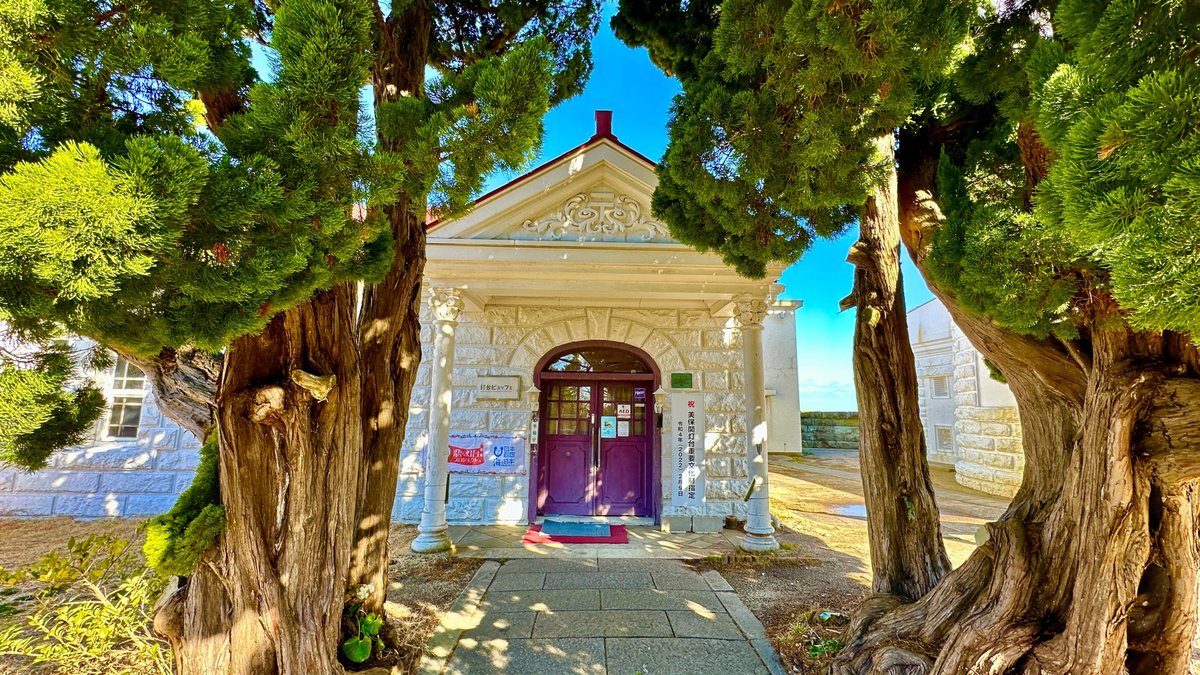
【島根時間.jp】第1回 美保関灯台:神話と海の交差点 時代を超える光の旅路
美保関灯台、その堂々たる石造りの姿は、1898年(明治31年)より島根半島の東端、地蔵崎の先端に立ち、日本海に面した山陰地方の航海の安全を見守ってきました。

この灯台の建設は、フランス人技師の手による先進的な設計によって実現し、西洋の技術と日本の建築美が見事に融合した形で誕生しました。その後、美保関灯台は国の重要文化財に指定されると同時に、「世界灯台100選」と「日本の灯台50選」に選出され、その文化的、歴史的価値が国際的に認められるに至りました。この灯台は、美保関地の御前島照射灯と共に、航路の安全を守るという共通の使命を持ち、航海の安全確保に重要な役割を担っています。

美保関灯台の所在する地蔵岬は、古くから航海の安全を祈願する地として知られ、お地蔵さんを奉納する場所として、海に出る人々の信仰の対象でした。中世に遡るこの伝統は、灯台がただの光源を超え、希望の象徴として地域社会に深く根ざしていることを物語っています。

灯台近くの鳥居は、美保神社の飛地境内への入口として機能し、訪れる人々に自然の壮大さと神聖なエネルギーを感じさせる場所となっています。この神聖な場所は、事代主神がタイを釣ったとされる伝説の地「地の御前」を望むことができ、神話と信仰が深く結びついた場所です。

1973年(昭和48年)に開通した「しおかぜライン」は、大山隠岐国立公園の一角としての美保関灯台へのアクセスを劇的に改善しました。この道路の開通により、より多くの人々がこの地を訪れるようになり、日本海の壮大な眺望を求める人々にとって重要な観光地となりました。灯台に隣接する石造りの建物は、かつて灯台職員の官舎として使用されていたもので、現在は灯台ビュッフェ(レストラン)として再利用されており、日本海を一望できる絶好のロケーションで、訪れる人々に特別な体験を提供しています。また、夏の期間には「いさり火カフェ」が開催され、日本海の伝統的な漁り火を背景に、地元の食材を使用した料理を楽しむことができます。

美保関灯台は、その建設から現代に至るまで、技術の進歩とともに自動化され、無人化されるなど、時代の変遷を経てきましたが、その役割と価値は変わることなく、地域の象徴として、また、文化遺産として大切にされ続けています。灯台とその周辺地域は、豊かな自然、深い歴史、そして根強い信仰が息づいており、美保関灯台はこれらを象徴する存在として、未来へとその価値を継承していく重要な役割を担っています。美保関灯台からの眺望は、海に生きる人々の希望の光として、また、この地を訪れる人々にとっての心の安らぎとなっています。


このように、美保関灯台は海を照らす灯台以上の存在として、地域の歴史と文化を今に伝え、未来へと継承していくことでしょう。過去から現代に至るまで、山陰地方の海の安全を守り続けるとともに、地域の歴史と文化の象徴としての役割も果たしてきた美保関灯台は、これからも多くの人々に愛され、記憶されていくことでしょう。灯台とその周辺の自然、神話、信仰が織りなす物語は訪れるすべての人々に深い感動を与え、この地の魅力を伝え続けるでしょう。美保関灯台は、地域の豊かな自然と共に、深い歴史、文化、信仰が息づく特別な場所として、未来へとその価値を継承していくことを願いながら、山陰地方の海の安全と地域の歴史を見守り続けます。

The Miho-no-Seki Lighthouse, with its imposing stone structure, has stood since 1898 at the eastern tip of the Shimane Peninsula, at the end of Jizozaki, facing the Sea of Japan. It has watched over the safety of navigation in the San'in region. The construction of this lighthouse was realized through the advanced design by a French engineer, beautifully merging Western technology and Japanese architectural beauty. Subsequently, the Miho-no-Seki Lighthouse was designated as a national important cultural property and selected for both the "Top 100 Lighthouses of the World" and the "Top 50 Lighthouses of Japan," recognizing its cultural and historical value internationally. Along with the Mihonoseki Lighthouse, it shares the common mission of safeguarding navigational safety, playing a vital role in ensuring the safety of sea travel.
Jizozaki, where the Miho-no-Seki Lighthouse is located, has been known since ancient times as a place for praying for safe navigation, serving as a site of devotion for those going out to sea. This medieval tradition signifies that the lighthouse transcends being merely a source of light, embedding deeply as a symbol of hope within the community. The nearby torii gate functions as the entrance to a detached precinct of the Miho Shrine, offering visitors a sense of nature's grandeur and sacred energy. This sacred site overlooks the legendary "Chi-no-Mae," where the deity Ebisu is said to have fished for sea bream, intertwining mythology and faith deeply.
The opening of the "Shiokaze Line" in 1973 dramatically improved access to the Miho-no-Seki Lighthouse as part of the Daisen-Oki National Park. This road's opening turned the area into a significant tourist destination for those seeking the majestic views of the Sea of Japan, with more people visiting. The stone building adjacent to the lighthouse, once used as the lighthouse keepers' quarters, has been repurposed as a lighthouse buffet (restaurant), offering a unique experience with panoramic views of the Sea of Japan. During summer, the "Isaribi Cafe" operates, allowing visitors to enjoy local cuisine against the backdrop of the traditional fishing fires of the Sea of Japan.
From its construction to the present, the Miho-no-Seki Lighthouse has undergone automation and unstaffing alongside technological advancements, yet its role and value remain unchanged. It continues to be cherished as a regional symbol and cultural heritage. The lighthouse and its surrounding area breathe rich nature, deep history, and strong faith, with the lighthouse symbolizing these aspects and playing a crucial role in passing on their value to the future. The view from the Miho-no-Seki Lighthouse serves as a beacon of hope for those at sea and a source of comfort for visitors.
Thus, the Miho-no-Seki Lighthouse is more than just a beacon illuminating the sea; it conveys the history and culture of the region to the present and into the future. Continuously protecting the safety of the Sea of Japan in the San'in region, the lighthouse also serves as a symbol of the area's history and culture. It will continue to be cherished and remembered by many. The stories woven by the lighthouse, its surrounding nature, mythology, and faith deeply move all visitors, perpetuating the charm of this location. The Miho-no-Seki Lighthouse, alongside the region's rich nature, history, culture, and faith, hopes to continue safeguarding the safety of the seas in the San'in region and watching over its historical narrative.
この記事が気に入ったらサポートをしてみませんか?
